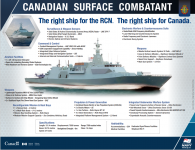CloudCover said:
9 and 9 would be a nice outcome.
In terms of platforms, that would be...actually somewhat unfortunate.
You'd be increasing the load on the training system by having multiple platforms, plus increasing the load on the maintenance facilities.
Going with a single platform means greater redundancy of parts, confluence of training, and the supply chain will be....happier....for it.
With the Halifax Class, there were a considerable number of systems that there were, quite literally, only 13 of ever built. 1 for each ship, and one for the school. As they broke, the one at the school got taken away, then they robbed from other ships, then they only supporting the single (or two) HR deployers, then they only supported based on the intended OP Area...
I believe we would be far better served as a small navy with a single class of ships.
My fear/concern is that the Government is going to look at the ~$60B price-tag, and cancel the whole shebang, and tell the Navy that instead, they're going to get a dozen extra AOPS after the 2 CCG ones are built...and the Navy can transfer whatever C3I capability to them that they can, and up-gun them from 25mm to deck mounted (non-deck penetrating configuration) 57mm, with 1x CEROS + 4x VLS cells plus a spot to plunk the CIWS....and a redesign of the mast to include the SMART-S. Max budget of an extra $100mil per AOPS.
They'd save billions doing that, and the general public for the most part doesn't know any different between one gray ship and another....so long as it's got a flag and a gun, they're happy.
NS



